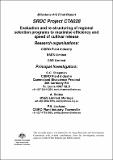| Abstract | Continual delivery of new cultivars is required to maintain resistance to existing and new pests and diseases, and to provide constant improvement in crop productivity, quality and profitability for an internationally competitive sugar industry. Sugarcane breeding comprises two major activities: genetic variation is created by crossing parents (selected on historical performance of their progeny in the case of proven parents, or performance for heritable traits in trials in the case of new parents), and the best clones for release are selected through a multi-stage selection process that involves progressively more intensive testing of fewer clones over several years in multiple sites. In Australia, the geographic variation in climate and other conditions in the different regions, the difficulties of moving sugar cane planting material, and differences between regions for some diseases (e.g. the Fiji disease line between the Central and Burdekin regions) had resulted in six cultivar crossing and selection programs, each targeting different regions: North (inc. Atherton Tableland), Herbert, Burdekin, Central, South and northern NSW. The small Ord irrigation area is serviced via testing and selection of elite clones from all of these regional trials. Currently crosses are made in each of four specific regions based on performance of parents (in trials or via progeny performance) in that region. Clones from crosses are initially chosen from small plots in one site per region. In further selection, breeders conduct multi-row plot trials across sites and seasons, with intensive testing within regions, and later exchange of the most promising clones between regions. At the start of this project, there was no basic information on whether clones generated directly from crosses generally perform consistently relative to each other between regions, or whether many clones exhibit specific adaptation to regional environments. This information, and quantifying the relative sizes of genotype, genotype x region interaction, and genotype x within-region interaction variances, in genetic populations generated in breeding programs, is basic information needed for designing an optimal selection system that collectively targets all regions. |

